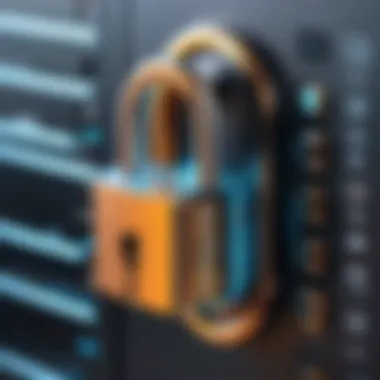Enhancing Cybersecurity at Home: A Deep Dive into UTM Solutions


Introduction to Cybersecurity and Network Security Convergence
In the escalating digital age, the significance of cybersecurity in today's interconnected world cannot be overstated. With the proliferation of online threats and malicious actors, safeguarding one's digital assets has become a paramount concern for individuals and organizations alike. The evolution of networking and security convergence underscores the need for comprehensive defense mechanisms to counter cyber attacks effectively.
Securing People, Devices, and Data
Implementing robust security measures is imperative for protecting every facet of digital data. From personal devices to sensitive information stored on networks, ensuring the integrity and confidentiality of data is crucial in thwarting cyber threats. Adopting proactive strategies to secure personal devices, networks, and data repositories is essential to preempt potential vulnerabilities and mitigate security risks effectively.
Latest Trends in Security Technologies
An in-depth exploration of emerging technologies in cybersecurity, such as Artificial Intelligence (AI), Internet of Things (Io T), and cloud security, sheds light on the dynamic landscape of cyber defense mechanisms. The analysis of how these innovations impact network security and data protection provides valuable insights into the evolving cybersecurity domain. Understanding the implications of contemporary security technologies is pivotal in devising proactive cybersecurity strategies to combat sophisticated cyber threats.
Data Breaches and Risk Management
Examining recent data breaches through insightful case studies illuminates the far-reaching implications of cybersecurity incidents on individuals and organizations. By identifying best practices for recognizing and mitigating cybersecurity risks, individuals can fortify their digital defenses against potential data breaches. Proactive risk management strategies are essential for enhancing cybersecurity resilience and safeguarding critical data assets.
Future of Cybersecurity and Digital Security Technology
Envisioning the future of the cybersecurity landscape involves predicting the trajectory of cybersecurity innovations and advancements. Insights into the innovative technologies that are shaping the digital security ecosystem offer a glimpse into the evolving nature of cyber defense strategies. By staying abreast of emerging trends and advancements in digital security technology, individuals can adapt their cybersecurity frameworks to meet the challenges posed by evolving cyber threats and mitigate potential risks effectively.
Introduction to UTM
Unified Threat Management (UTM) is a critical component of enhancing cybersecurity for home users. In the digital age, where online threats are rampant, understanding the basics and implementing UTM solutions can significantly bolster defenses against cyber attacks. By delving into the realm of UTM, users can protect their digital assets effectively and mitigate potential risks.
What is UTM?
Definition of UTM:
UTM, in essence, combines various security features into a single, unified platform to provide comprehensive protection against a multitude of cyber threats. This integrated approach streamlines security measures and simplifies management for home users. The versatility and efficiency of UTM make it an indispensable tool in fortifying defenses against evolving cybersecurity challenges, ensuring a holistic approach to safeguarding networks and devices.
Components of UTM:


The components of UTM encompass a range of security functions, including firewall, intrusion detection and prevention, antivirus, and anti-malware capabilities. Each component plays a crucial role in fortifying the overall security posture of home networks. From monitoring network traffic to detecting and neutralizing potential threats, these components work together seamlessly to create a robust defense mechanism.
Importance of UTM for Home Users
Cybersecurity Threats Faced by Home Users:
Home users are increasingly susceptible to a myriad of cybersecurity threats, ranging from malware infections to phishing scams. With the proliferation of connected devices and online activities, the risk of falling victim to cyber attacks is higher than ever. UTM serves as a shield against these threats, offering a layered defense strategy to detect and thwart malicious intents effectively.
Benefits of Implementing UTM at Home:
Implementing UTM at home brings a host of benefits, including enhanced network security, real-time threat detection, and peace of mind knowing that digital assets are safeguarded. By proactively preventing security breaches and minimizing vulnerabilities, UTM empowers home users to browse the internet, communicate online, and conduct transactions securely. The proactive approach of UTM complements traditional security measures and ensures comprehensive protection against emerging threats.
Key Features of UTM Solutions
UTM (Unified Threat Management) solutions are paramount in enhancing cybersecurity for home users. These solutions offer a comprehensive approach, incorporating various security components into a single platform for effective threat management. By bundling firewall protection, intrusion detection and prevention, antivirus, and anti-malware capabilities, UTM solutions provide a robust defense mechanism against digital threats. Home users can benefit significantly from the all-encompassing nature of UTM solutions, as they streamline security management and minimize vulnerabilities by addressing multiple attack vectors simultaneously. When considering UTM solutions, it is crucial to evaluate the specific features offered by different providers to ensure comprehensive protection tailored to individual cybersecurity needs.
Firewall Protection
Understanding Firewall Functionality
Understanding the functionality of a firewall is crucial for securing home networks. A firewall acts as a barrier between internal and external networks, monitoring incoming and outgoing traffic to block unauthorized access and potential threats. The key characteristic of firewall functionality lies in its ability to filter network data based on predefined security rules, allowing legitimate traffic while blocking suspicious or malicious packets. This proactive approach to network security enhances overall data protection and privacy for home users, making it a popular choice in the context of cybersecurity. A unique feature of firewall functionality is its capacity to create access control policies, regulating network traffic flow and reducing the risk of unauthorized intrusions. However, one drawback of firewall functionality is that it solely focuses on network traffic filtering and may not provide complete protection against advanced cyber threats.
Role of Firewall in UTM
The firewall plays a vital role within UTM solutions by serving as the first line of defense against cyber threats. Its primary function is to monitor and filter incoming and outgoing data packets, enforcing security policies to prevent unauthorized access and malicious activities. The key characteristic of the firewall in UTM is its ability to establish secure boundaries for network traffic, segregating trusted and untrusted sources to thwart potential attacks. This proactive security measure significantly enhances the overall effectiveness of UTM solutions in safeguarding home networks against various cyber threats. A unique feature of the firewall in UTM is its integration with other security components, such as intrusion detection and antivirus capabilities, to provide layered protection. While the firewall is essential for network security, its reliance on predefined rules and signatures may pose limitations in detecting evolving cyber threats, urging the need for continuous updates and monitoring within UTM environments.
Intrusion Detection and Prevention
Detection of Suspicious Activities
Intrusion detection plays a critical role in identifying and alerting against unauthorized access attempts or malicious activities within a network. By employing sophisticated algorithms and threat intelligence, intrusion detection systems analyze network traffic patterns to detect anomalies indicative of potential security breaches. The key characteristic of detecting suspicious activities lies in the system's ability to differentiate between normal and abnormal behavior, thereby triggering alerts for prompt investigation and remediation. This proactive approach strengthens the overall security posture of home networks, making intrusion detection an essential component of UTM solutions. A unique feature of detecting suspicious activities is its capacity to conduct real-time monitoring and analysis, enabling rapid response to emerging threats and enhancing incident response capabilities. However, the efficacy of intrusion detection systems may be contingent upon continuous updates and fine-tuning to adapt to evolving cyber threats.
Preventing Intrusions with UTM


Intrusion prevention complements detection by actively blocking malicious activities before they can compromise network integrity. By leveraging predefined security policies and threat intelligence, intrusion prevention systems work in tandem with firewalls to evaluate incoming traffic and prevent suspicious behavior from infiltrating the network. The key characteristic of preventing intrusions with UTM is its proactiveness in blocking potential threats based on known attack signatures and behaviors, thereby reducing the likelihood of successful cyber attacks. This integrated approach fortifies home networks against a wide range of intrusion attempts, making intrusion prevention a crucial aspect of UTM solutions. A unique feature of preventing intrusions with UTM is its ability to automate threat responses, dynamically adjusting security controls based on detected threats to enhance overall network resilience. Despite its proactive nature, intrusion prevention systems may encounter challenges in dealing with zero-day attacks and sophisticated evasion techniques, necessitating continuous monitoring and threat intelligence updates within UTM environments.
Antivirus and Anti-Malware Capabilities
Scanning for Malicious Software
Antivirus and anti-malware functionalities are indispensable for detecting and eliminating malicious software threats targeting home devices. By conducting regular scans of system files, applications, and incoming data, antivirus programs identify and isolate potentially harmful software before it can cause damage. The key characteristic of scanning for malicious software lies in the program's ability to match file signatures against known malware definitions, enabling quick detection and removal of threats. This proactive measure safeguards home devices from a multitude of malware types, making antivirus scanning a pivotal component of UTM solutions. A unique feature of scanning for malicious software is its heuristic analysis capabilities, allowing antivirus programs to identify suspicious behaviors and anomalies that may signify new or unknown threats. However, relying solely on signature-based scanning may pose limitations in detecting polymorphic malware variants and zero-day attacks, underscoring the importance of employing advanced threat detection techniques within UTM deployments.
Protecting Devices from Malware Attacks
Protecting devices from malware attacks involves deploying robust defenses capable of mitigating various infection vectors and attack techniques. Anti-malware capabilities within UTM solutions focus on preventing malware infections through real-time scanning, malicious code analysis, and behavioral monitoring of device activities. The key characteristic of protecting devices from malware attacks lies in the comprehensive security measures employed to block, quarantine, or eradicate malicious software instances, safeguarding home devices from potential breaches. This proactive approach enhances the overall resilience of home networks against evolving malware threats, positioning anti-malware functionalities as integral components of UTM solutions. A unique feature of protecting devices from malware attacks is its capacity to leverage machine learning algorithms and sandboxing techniques to identify and neutralize emerging malware strains, bolstering defensive mechanisms. However, anti-malware solutions may face challenges in dealing with fileless malware and sophisticated evasion tactics, necessitating continuous updates and behavioral analysis to counter emerging threat landscapes within the realm of home cybersecurity.
Implementing UTM for Home Networks
Implementing UTM for Home Networks plays a pivotal role in fortifying cybersecurity defenses within domestic environments. As cyber threats continue to evolve and target personal devices, the implementation of Unified Threat Management (UTM) solutions becomes increasingly crucial. By incorporating UTM into home networks, individuals can enhance their ability to safeguard sensitive data and protect against various online attacks. This section delves into the significance of integrating UTM for securing home computing environments.
Choosing the Right UTM Solution
Factors to Consider
Factors to Consider when selecting a UTM solution are essential for optimizing cybersecurity measures at home. Understanding the specific requirements of one's network and devices is fundamental in choosing the most suitable UTM solution. Factors such as the level of protection needed, compatibility with existing systems, ease of use, and scalability are key considerations. By evaluating these aspects comprehensively, individuals can ensure that the chosen UTM solution aligns with their cybersecurity objectives effectively.
Popular UTM Providers
In the realm of UTM solutions, Popular UTM Providers offer a diverse range of features and functionalities to address varying cybersecurity needs. These providers have established credibility in delivering reliable services and comprehensive protection against cyber threats. By exploring the offerings of Popular UTM Providers, individuals can gain insights into industry-leading security technologies and choose a solution that best fits their home network requirements. Evaluating the reputation, customer reviews, and performance of Popular UTM Providers will aid in making an informed decision on enhancing cybersecurity defenses at home.
Installation and Configuration
Step-by-Step Guide
A Step-by-Step Guide for the installation and configuration of UTM solutions is critical for ensuring seamless deployment and operation. This comprehensive guide outlines the necessary steps to set up UTM devices effectively. From establishing network connectivity to configuring security settings, each step is meticulously detailed to simplify the installation process. By following a systematic approach outlined in the Step-by-Step Guide, individuals can deploy UTM solutions with confidence and optimize their home network's cybersecurity posture.


Customizing UTM Settings
Customizing UTM Settings enables users to tailor security parameters according to their specific requirements and preferences. By customizing settings such as firewall rules, intrusion detection thresholds, and malware scanning protocols, individuals can fine-tune the protection provided by UTM solutions. Understanding how to customize UTM Settings empowers users to adapt security configurations based on evolving cybersecurity threats. This section highlights the advantages of customizing UTM Settings and provides guidelines for optimizing security protocols within home networks.
Best Practices for UTM Usage
In this ultimate guide to UTM for home users, the section on Best Practices for UTM Usage plays a critical role in enhancing cybersecurity measures. By adhering to these best practices, individuals can fortify their defenses against a myriad of online threats effectively. The significance of this topic lies in its ability to empower users with the knowledge and strategies necessary to safeguard their digital assets comprehensively. Implementing best practices for UTM ensures a proactive approach towards cybersecurity, creating a robust shield against potential breaches and cyber attacks.
Regular Updates and Maintenance
Ensuring Latest Security Patches
Within the realm of UTM for home networks, ensuring the installation of the latest security patches is paramount. This proactive measure significantly contributes to the overall security posture by addressing known vulnerabilities and fortifying system defenses against emerging threats. The key characteristic of ensuring latest security patches is its ability to preemptively mitigate security risks, bolstering the resilience of the network infrastructure. By promptly updating security patches, home users can stay ahead of cyber threats, minimizing the likelihood of successful attacks. The unique feature of this practice lies in its time-sensitive nature, where timely patching is crucial to maintaining robust cybersecurity defenses.
Scheduled System Checks
Scheduled system checks form an integral part of UTM usage best practices by facilitating routine assessments of the network environment. This proactive approach allows users to monitor system health, detect anomalies, and rectify potential security gaps promptly. The key characteristic of scheduled system checks is their proactive nature, enabling preemptive identification of security vulnerabilities before they are exploited. By integrating scheduled system checks into regular UTM maintenance, home users can ensure the continuous integrity of their cybersecurity measures. The unique feature of this practice is its automation capabilities, streamlining the monitoring process and enhancing network security without requiring constant manual oversight.
User Training and Awareness
Cybersecurity Education for Home Users
The aspect of cybersecurity education for home users plays a pivotal role in augmenting overall security measures within a UTM framework. By imparting essential knowledge on cybersecurity best practices and threat awareness, home users can effectively mitigate risks and enhance their digital defense mechanisms. The key characteristic of cybersecurity education is its role in empowering individuals with the requisite skills to identify and respond to cyber threats proactively. This practice emphasizes the importance of continuous learning and adaptation to evolving security challenges, equipping users with the tools to combat sophisticated cyber attacks effectively. The unique feature of this educational approach is its emphasis on practical application, providing users with actionable insights to fortify their cybersecurity posture.
Recognizing Phishing Attempts
Recognizing phishing attempts is a crucial component of user training and awareness in the context of UTM deployment for home networks. By understanding the telltale signs of phishing attacks and cultivating a vigilant mindset, home users can thwart potentially damaging cyber schemes effectively. The key characteristic of recognizing phishing attempts is its focus on enhancing users' discernment and critical thinking skills when interacting with online content. This practice underscores the significance of skepticism and verification in mitigating the risks posed by phishing ploys. The unique feature of this training is its emphasis on real-world scenarios and practical exercises, enabling users to apply their knowledge in identifying and mitigating phishing threats effectively.
Conclusion
Securing Your Home Network with UTM
Summarizing the Benefits of UTM
Delving into the specifics of the benefits derived from UTM utilization is vital in understanding its significance within the realm of cybersecurity. Summarizing the key advantages UTM offers allows users to grasp its comprehensive security approach, combining various essential features like firewall protection, intrusion detection, and antivirus capabilities in a single solution. The seamless integration of these elements contributes to a robust defense mechanism, enhancing overall network resilience. One of the distinctive features of Summarizing the Benefits of UTM is its capacity to streamline security operations, making it an efficient and popular choice among users seeking a unified approach to threat management. While UTM undoubtedly presents numerous advantages, it is essential to acknowledge that the effectiveness of UTM can vary based on individual user requirements and network configurations, necessitating a tailored approach to maximize its benefits.
Empowering Users to Defend Against Cyber Threats
Empowering Users to Defend Against Cyber Threats accentuates the user-centric approach that UTM advocates, focusing on enhancing cybersecurity awareness and preparedness. By educating users on potential threats and imparting knowledge on recognizing and mitigating cyber risks like phishing attempts, UTM empowers individuals to actively engage in protecting their digital assets. The key characteristic of this aspect lies in its proactive stance, equipping users with the information and tools essential for navigating the intricate landscape of cyber threats effectively. A unique feature of Empowering Users to Defend Against Cyber Threats is its emphasis on user training as a fundamental component of cybersecurity resilience, thereby fostering a culture of vigilance and security consciousness among home users. While there are clear advantages to bolstering user defenses, it is crucial to recognize that user empowerment should be complemented by robust technological solutions to establish a holistic approach to cybersecurity.







